Monthly Precipitation Outlooks for Mexico Using El Niño Southern Oscillation Indices Approach
Abstract
:1. Introduction
2. Methodology
2.1. Area of Study
2.2. ENSO Indices and Precipitation
2.3. Decision Tree Classifier Model
2.4. Assessments
3. Results
3.1. ENSO 3.4 Indices and Similar Months
3.2. Overall Model Efficiency and Probability of Detection
3.3. Spatial Percent of Correct, Bias, and Correlations
4. Discussion
5. Summary and Conclusions
Author Contributions
Funding
Institutional Review Board Statement
Informed Consent Statement
Data Availability Statement
Acknowledgments
Conflicts of Interest
Abbreviations
| Abbreviation | Definition |
| ENSO3.4 | El Niño Southern Oscillation Region 3.4 |
| CHIRPS2.0 | The Climate Hazards Group InfraRed Precipitation with Station, second version |
| Acronyms | |
| TIi…n | Target Index months based on ENSO3.4 Indices from December 2000 to November 2023 |
| HIi…n | Historically index months based on ENSO3.4 Indices from December 1950 to November 2000 |
| Lag0 | No Lag applied to monthly Indices |
| Lag–5 | Five-month Lag applied to monthly Indices |
| PTri…n | Training precipitation months from December 1950 to November 2000 (based on ENSO3.4 Indices) |
| PTsi…n | Testing precipitation months from December 2000 to November 2023 (based on ENSO3.4 Indices) |
| KSS | Hansen–Kuipers Skill Score metric to evaluate seasonally overall model performance (nationwide scale) |
| HSS | Heidke Skill Score metric to evaluate seasonally overall model performance (nationwide scale) |
| sPC | Spatial Percent of Correct to evaluate locally (pixel scale) and seasonally the model performance |
| sBias | Spatial Bias to detect locally (pixel scale) and seasonally over/underestimation model performance |
| srho | Spearman Correlation to detect locally (pixel scale) and seasonally significant correlations (p ≤ 0.10) |
References
- Wedgbrow, C.S.; Wilby, R.L.; Fox, H.R.; O’Hare, G. Prospects for seasonal forecasting of summer drought and low river flow anomalies in England and Wales. Int. J. Climatol. 2002, 22, 219–236. [Google Scholar] [CrossRef]
- NOAA—National Oceanic and Atmospheric Administration. National Centers for Environmental Information, Global Climate Reports: 2011, 2012, 2013, 2014, 2015, 2016. Available online: https://www.ncdc.noaa.gov/sotc/global/ (accessed on 5 July 2022).
- Conde, C.; Ferrer, R.; Orozco, S. Climate change and climate variability impacts on rain-fed agricultural activities and possible adaptation measures. A Mexican case study. Atmósfera 2006, 19, 181–194. [Google Scholar]
- CONAGUA/SMN-Comisión Nacional del Agua/Servicio Meteorológico Nacional, Seguimiento Mensual de Afectación por sequía. Available online: https://smn.conagua.gob.mx/tools/DATA/Climatología/Sequía/Monitor%20de%20sequía%20en%20America%20del%20Norte/sequia1211.pdf (accessed on 20 December 2022).
- SIAP-Sistema de Información Agroalimentaria y Pesquera, Anuario Estadístico de la Producción Agrícola 2011. Available online: https://nube.siap.gob.mx/cierreagricola/ (accessed on 10 November 2022).
- International Research Institute for Climate Prediction-IRI, IDB-ENSO Project IMPACTS. Available online: https://iri.columbia.edu/~idb_enso/luisbrito/Impacts.html#:~:text=Muchos%20países%20tomaron%20acciones%20preventivas,de%20600%20millones%20de%20dólares (accessed on 18 January 2022).
- Delgadillo, J.; Rodríguez, D.; Aguilar, T. Los aspectos económicos y sociales de El Niño. In Los Impactos de El Niño en México; Magaña, V., Ed.; Dirección General de Protección Civil, Secretaría de Gobernación: Ciudad de México, Mexico, 1999; pp. 181–210. [Google Scholar]
- Butler, A.H.; Polvani, L.M. El Niño, La Niña, and stratospheric sudden warmings: A reevaluation in light of the observational record. Geophys. Res. Lett. 2011, 38, L13807. [Google Scholar] [CrossRef]
- Vega-Camarena, J.P.; Brito-Castillo, L.; Pineda-Martínez, L.F.; Farfán, L.M. ENSO Impact on Summer Precipitation and Moisture Fluxes over the Mexican Altiplano. J. Mar. Sci. Eng. 2023, 11, 1083. [Google Scholar] [CrossRef]
- Hegyi, B.M.; Deng, Y. A Dynamical Fingerprint of Tropical Pacific Sea Surface Temperatures on the Decadal-Scale Variability of Cool-Season Arctic Precipitation. J. Geophys. Res. 2011, 116, D20121. [Google Scholar] [CrossRef]
- Di Lorenzo, E.; Cobb, K.M.; Furtado, J.; Schneider, N.; Anderson, B.; Bracco, A.; Alexander, M.A.; Vimont, D. Central Pacific El Niño and decadal climate change in the North Pacific. Nat. Geosci. 2010, 3, 762–765. [Google Scholar] [CrossRef]
- Yang, X.; DelSole, T. Systematic comparison of ENSO teleconnection patterns between models, observations. J. Clim. 2012, 25, 425–446. [Google Scholar] [CrossRef]
- Bell, C.J.; Gray, L.J.; Charlton-Perez, A.J.; Joshi, M.M.; Scaife, A.A. Stratospheric Communication of El Niño Teleconnections to European Winter. J. Clim. 2009, 22, 4083–4096. [Google Scholar] [CrossRef]
- Cagnazzo, C.; Manzini, E. Impact of the stratosphere on the Winter tropospheric teleconnections between ENSO and the North Atlantic and European Region. J. Clim. 2009, 22, 1223–1238. [Google Scholar] [CrossRef]
- Vicente-Serrano, S.M.; López-Moreno, J.I.; Gimeno, L.; Nieto, R.; Morán-Tejeda, E.; Lorenzo-Lacruz, J.; Beguería, S.; Azorin-Molina, C. A multiscalar global evaluation of the impact of ENSO on droughts. J. Geophys. Res. Atmos. 2011, 116, D20109. [Google Scholar] [CrossRef]
- Mendez-González, J.; Návar-Cháidez, J.D.J.; González-Rodríguez, H.; Treviño-Garza, E.J. Teleconexiones del fenómeno ENSO a la precipitación mensual en México. Cienc. UANL 2007, 10, 290–298. [Google Scholar]
- Adams, R.M.; Houston, L.L.; McCarl, B.A.; Tiscareño, M.; Matus, J.; Weiher, R.F. The benefits to Mexican agriculture of an El Niño-Southern Oscillation (ENSO) early warning system. Agric. For. Meteorol. 2003, 115, 183–194. [Google Scholar] [CrossRef]
- Corrales-Suastegui, A.; González-Jasso, L.A.; Narváez-Mendoza, M.P.; González González, M.A.; Ruiz Álvarez, O.; Maciel-Pérez, L.H. PronEst: Aplicación Informática para Generar Pronósticos Estacionales de Lluvias y Heladas de uno a Tres Meses, 1st ed.; Comité Editorial del CEPAB-INIFAP: Pabellón de Arteaga, Mexico, 2014; Folleto Técnico Núm. 62; pp. 1–21. ISBN 978-607-37-0381-9. [Google Scholar]
- Englehart, P.J.; Douglas, A.V. The role of eastern North Pacific tropical storms in the rainfall climatology of western Mexico. Int. J. Climatol. J. R. Meteorol. Soc. 2001, 21, 1357–1370. [Google Scholar] [CrossRef]
- Gay-García, C.; Hernández-Vazquez, J.; Jiménez-López, J.; Lezama-Gutiérrez, J.; Magaña-Rueda, V.M.; Morales-Acoltzi, T.; Orozco-Flores, S. Evaluation of Climatic forecasts of rainfall for the Tlaxcala State (Mexico): 1998–2002. Atmósfera 2004, 17, 127–150. [Google Scholar]
- Modaresi, F.; Ebrahimi, K.; Danandeh Mehr, A. A novel approach to predictor selection among large-scale climate Indices for seasonal rainfall forecasting in small catchments. Hydrol. Sci. J. 2024, 69, 488–505. [Google Scholar] [CrossRef]
- Qian, Q.; Jia, X.; Lin, H.; Zhang, R. Seasonal forecast of non monsoonal winter precipitation over the Eurasian continent using machine-learning models. J. Clim. 2021, 34, 7113–7129. [Google Scholar] [CrossRef]
- Yaseen, Z.M.; Ali, M.; Sharafati, A.; Al-Ansari, N.; Shahid, S. Forecasting standardized precipitation Index using data intelligence models: Regional investigation of Bangladesh. Sci. Rep. 2021, 11, 3435. [Google Scholar] [CrossRef]
- Lou, D.; Yang, M.; Shi, D.; Wang, G.; Ullah, W.; Chai, Y.; Chen, Y. K-Means and c4.5 decision tree-based prediction of long-term precipitation variability in the Poyang Lake basin China. Atmosphere 2021, 12, 834. [Google Scholar] [CrossRef]
- Feng, P.; Wang, B.; Liu, D.L.; Ji, F.; Niu, X.; Ruan, H.; Shi, L.; Yu, Q. Machine learning-based integration of large-scale climate drivers can improve the forecast of seasonal rainfall probability in Australia. Environ. Res. Lett. 2020, 15, 084051. [Google Scholar] [CrossRef]
- Sattari, M.T.; Shaker Sureh, F.; Kahya, E. Monthly precipitation assessments in association with atmospheric circulation Indices by using tree-based models. Nat. Hazards 2020, 102, 1077–1094. [Google Scholar] [CrossRef]
- Xiang, B.; Zeng, C.; Dong, X.; Wang, J. The application of a decision tree and stochastic forest model in summer precipitation prediction in Chongqing. Atmosphere 2020, 11, 508. [Google Scholar] [CrossRef]
- Wei, W.; Yan, Z.; Jones, P. A decision-tree approach to seasonal prediction of extreme precipitation in eastern China. Int. J. Climatol. 2020, 40, 255–272. [Google Scholar] [CrossRef]
- Wei, W.; Yan, Z.; Tong, X.; Han, Z.; Ma, M.; Yu, S.; Xia, J. Seasonal prediction of summer extreme precipitation over the Yangtze River based on random forest. Weather. Clim. Extrem. 2022, 37, 100477. [Google Scholar] [CrossRef]
- Saha, M.; Nanjundiah, R.S. Prediction of the ENSO and EQUINOO indices during June–September using a deep learning method. Meteorol. Appl. 2020, 27, e1826. [Google Scholar] [CrossRef]
- Begum, B.; Tajbar, S.; Khan, B.; Rafiq, L. Identification of relationships between climate Indices and precipitation fluctuation in Peshawar City-Pakistan. J. Res. Environ. Earth Sci. 2021, 10, 264–278. [Google Scholar]
- Ramírez-Carlos, B. Manual del Busca Ciclones, Versión 3.0. Subdirección de Riesgos Hidrometeorológicos. Sistema Nacional de Protección Civil Centro Nacional de Prevención de Desastres SEGOB-CENAPRED. 2017, pp. 1–12. Available online: https://www1.cenapred.unam.mx/COORDINACION_ADMINISTRATIVA/SRM/FRACCION_XLI_A/72.pdf (accessed on 3 December 2022).
- López-Cruz, A.; Soto-Pinto, L.; Salgado-Mora, M.G.; Huerta-Palacios, G. Simplification of the structure and diversity of cocoa agroforests does not increase yield nor influence frosty pod rot in El Soconusco, Chiapas, Mexico. Agrofor. Syst. 2021, 95, 201–214. [Google Scholar] [CrossRef]
- Perdigon-Morales, J.; Romero-Centeno, R.; Perez, P.O.; Barrett, B.S. The midsummer drought in Mexico: Perspectives on duration intensity from the CHIRPS precipitation database. Int. J. Climatol. 2018, 38, 2174–2186. [Google Scholar] [CrossRef]
- Corrales-Suastegui, A.; Fuentes-Franco, R.; Pavia, E.G. The mid-summer drought over Mexico and Central America in the 21st century. Int. J. Climatol. 2019, 40, 1703–1715. [Google Scholar] [CrossRef]
- Walkowiak, A.M.; Solana, E. Distribución Estacional De Lluvias En Baja California, México. Análisis De Probabilidades. Atmósfera 1989, 2, 209–218. [Google Scholar]
- Barnston, A.G.; Chelliah, M.; Goldenberg, S.B. Documentation of a highly ENSO-related SST region in the equatorial Pacific. Atmos.-Ocean. (Can. Meteorol. Oceanogr. Soc.) 1997, 35, 367. [Google Scholar]
- NOAA-National Oceanic and Atmospheric Administration. CPC-Climate Prediction Center, Monthly Atmospheric & SST Indices. Available online: https://www.cpc.ncep.noaa.gov/data/indices/ersst5.nino.mth.91-20.ascii (accessed on 10 January 2022).
- Livneh, B.; Bohn, T.J.; Pierce, D.S.; Munoz-Ariola, F.; Nijssen, B.; Cayan, D.; Vose, R.; Brekki, L.D. Development of a spatially comprehensive, daily hydrometeorological data set for Mexico, the conterminous U.S., and southern Canada 1950–2013. Nat. Sci. Data 2015, 2, 150042. [Google Scholar] [CrossRef]
- Funk, C.; Peterson, P.; Landsfeld, M.; Pedreros, D.; Verdin, J.; Shukla, S.; Husak, G.; Rowland, J.; Harrison, L.; Hoell, A.; et al. The climate hazards infrared precipitation with stations—A new environmental record for monitoring extremes. Sci. Data 2015, 2, 150066. [Google Scholar] [CrossRef] [PubMed]
- Fuentes-Franco, R.; Giorgi, F.; Pavia, E.G.; Graef, F.; Coppola, E. Seasonal precipitation forecast over Mexico based on a hybrid statistical–dynamical approach. Int. J. Climatol. 2018, 38, 4051–4065. [Google Scholar] [CrossRef]
- Magallanes-Quintanar, R.; Galván-Tejada, C.E.; Galván-Tejada, J.I.; Méndez-Gallegos, S.D.J.; García-Domínguez, A.; Gamboa-Rosales, H. Narx neural networks models for prediction of standardized precipitation Index in central Mexico. Atmosphere 2022, 13, 1254. [Google Scholar] [CrossRef]
- Magaña, V.O.; Vázquez, J.L.; Pérez, J.L.; Pérez, J.B. Impact of El Niño on precipitation in Mexico. Geofísica Int. 2003, 42, 313–330. Available online: https://www.redalyc.org/articulo.oa?id=56842304 (accessed on 2 May 2024). [CrossRef]
- Bravo, J.L.; Azpra, E.; Zarraluqui, V.; Gay, C. Some variations of the rainfall in Mexico City from 1954 to 1988 and their statistical significance. Atmósfera 2014, 27, 367–376. [Google Scholar] [CrossRef]
- Chen, Y.; Huang, X.; Luo, J.-J.; Lin, Y.; Wright, J.S.; Lu, Y.; Chen, X.; Jiang, H.; Lin, P. Prediction of ENSO using multivariable deep learning. Atmos. Ocean. Sci. Lett. 2023, 16, 100350. [Google Scholar] [CrossRef]
- Adams, D.K.; Comrie, A.C. The North American Monsoon. Bull. Am. Meteor. Soc. 1997, 78, 2197–2214. [Google Scholar] [CrossRef]
- Bravo-Cabrera, J.L.; Azpra-Romero, E.; Zarraluqui-Such, V.; Gay-García, C. Effects of El Niño in Mexico during rainy and dry seasons: An extended treatment. Atmósfera 2017, 30, 221–232. [Google Scholar] [CrossRef]
- Korecha, D.; Sorteberg, A. Validation of operational seasonal rainfall forecast in Ethiopia. Water Resour. Res. 2013, 49, 7681–7697. [Google Scholar] [CrossRef]
- Bhattacharya, T.; Chiang, J.C. Spatial variability and mechanisms underlying El Niño-induced droughts in Mexico. Clim. Dyn. 2014, 43, 3309–3326. [Google Scholar] [CrossRef]
- Andrade-Velázquez, M.; Medrano-Pérez, O.R. Precipitation patterns in Usumacinta and Grijalva basins (southern Mexico) under a changing climate. Rev. Bio Cienc. 2020, 7, 1–22. [Google Scholar] [CrossRef]
- Medrano-Pérez, O.R. Ciudades sobrecargadas: La sobreexplotación de recursos como limitante del desarrollo sustentable. Antipod. Rev. Antropol. Arqueol. 2020, 39, 3–12. [Google Scholar] [CrossRef]
- Campos, M.N.; Cárdenas, O.L.; Gaxiola, A.; González, G.E.G. Meteorological interaction between drought/oceanic indicators and rainfed maize yield in an arid agricultural zone in northwest Mexico. Arab. J. Geosci. 2020, 13, 131. [Google Scholar] [CrossRef]
- Montero-Martínez, M.J.; Pita-Díaz, O.; Andrade-Velázquez, M. Potential influence of the atlantic multidecadal oscillation in the recent climate of a small basin in Central Mexico. Atmosphere 2022, 13, 339. [Google Scholar] [CrossRef]
- Nguyen, P.L.; Min, S.K.; Kim, Y.H. Combined impacts of the El Niño-Southern Oscillation and Pacific decadal oscillation on global droughts assessed using the standardized precipitation evapotranspiration Index. Int. J. Climatol. 2021, 41, E1645–E1662. [Google Scholar] [CrossRef]
- Mijares-Fajardo, R.; Lobato-Sánchez, R.; Patiño-Gómez, C.; Guevara-Polo, D.E. Atlantic and Pacific Sea surface temperature correlations with precipitation over northern Mexico. Atmósfera 2024, 38, 217–234. [Google Scholar] [CrossRef]
- Crochemore, L.; Ramos, M.H.; Pappenberger, F. Bias correcting precipitation forecasts to improve the skill of seasonal streamflow forecasts. Hydrol. Earth Syst. Sci. 2016, 20, 3601–3618. [Google Scholar] [CrossRef]
- Manzanas, R.; Lucero, A.; Weisheimer, A.; Gutiérrez, J.M. Can bias correction and statistical downscaling methods improve the skill of seasonal precipitation forecasts? Clim. Dyn. 2018, 50, 1161–1176. [Google Scholar] [CrossRef]
- Manzanas, R.; Gutiérrez, J.M. Process-conditioned bias correction for seasonal forecasting: A case-study with ENSO in Peru. Clim. Dyn. 2019, 52, 1673–1683. [Google Scholar] [CrossRef]
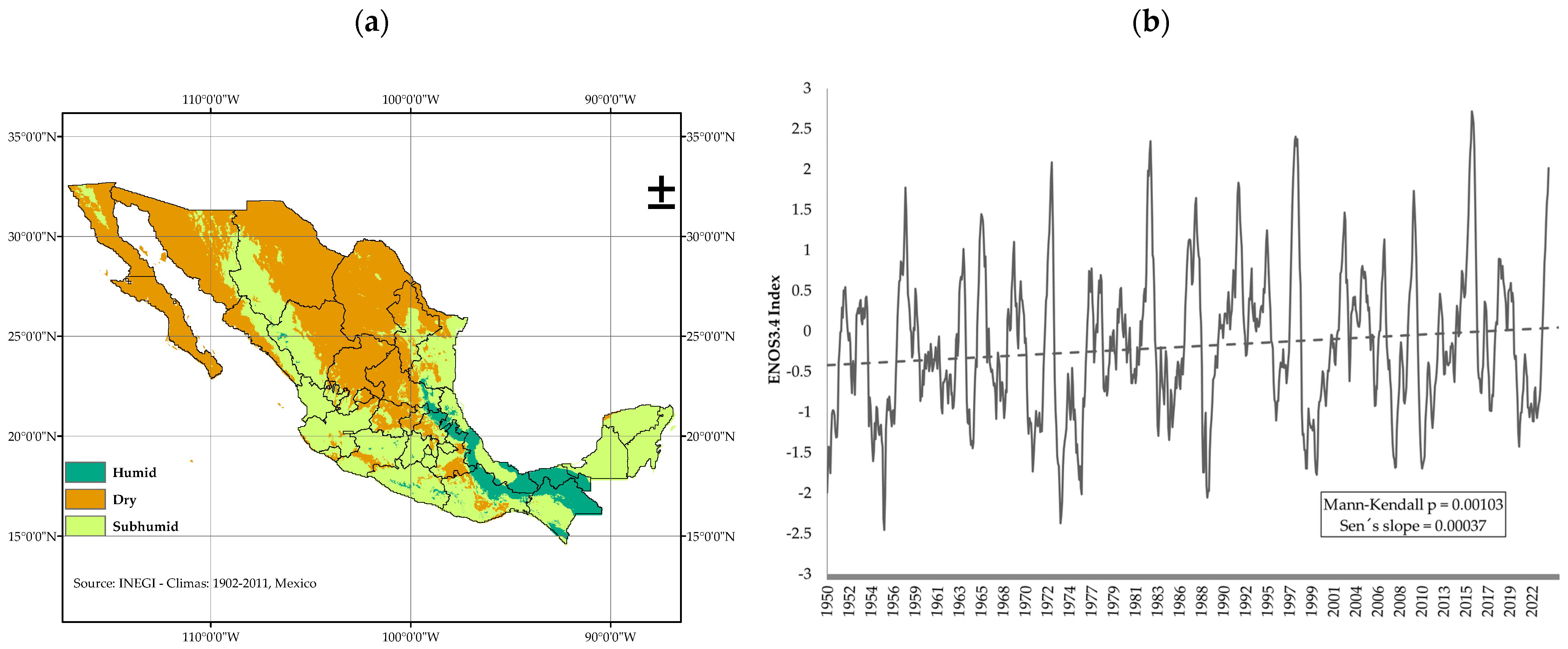
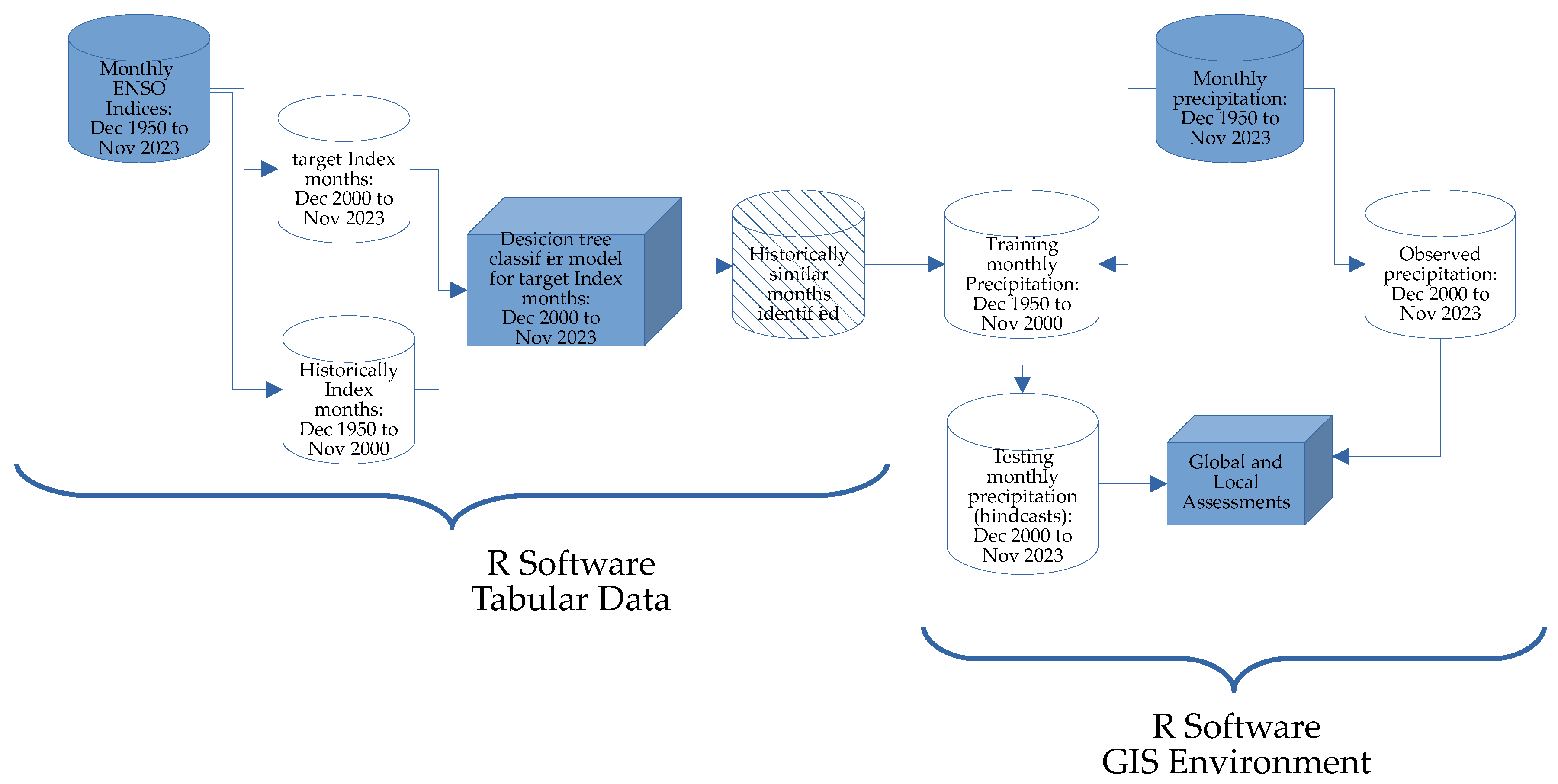
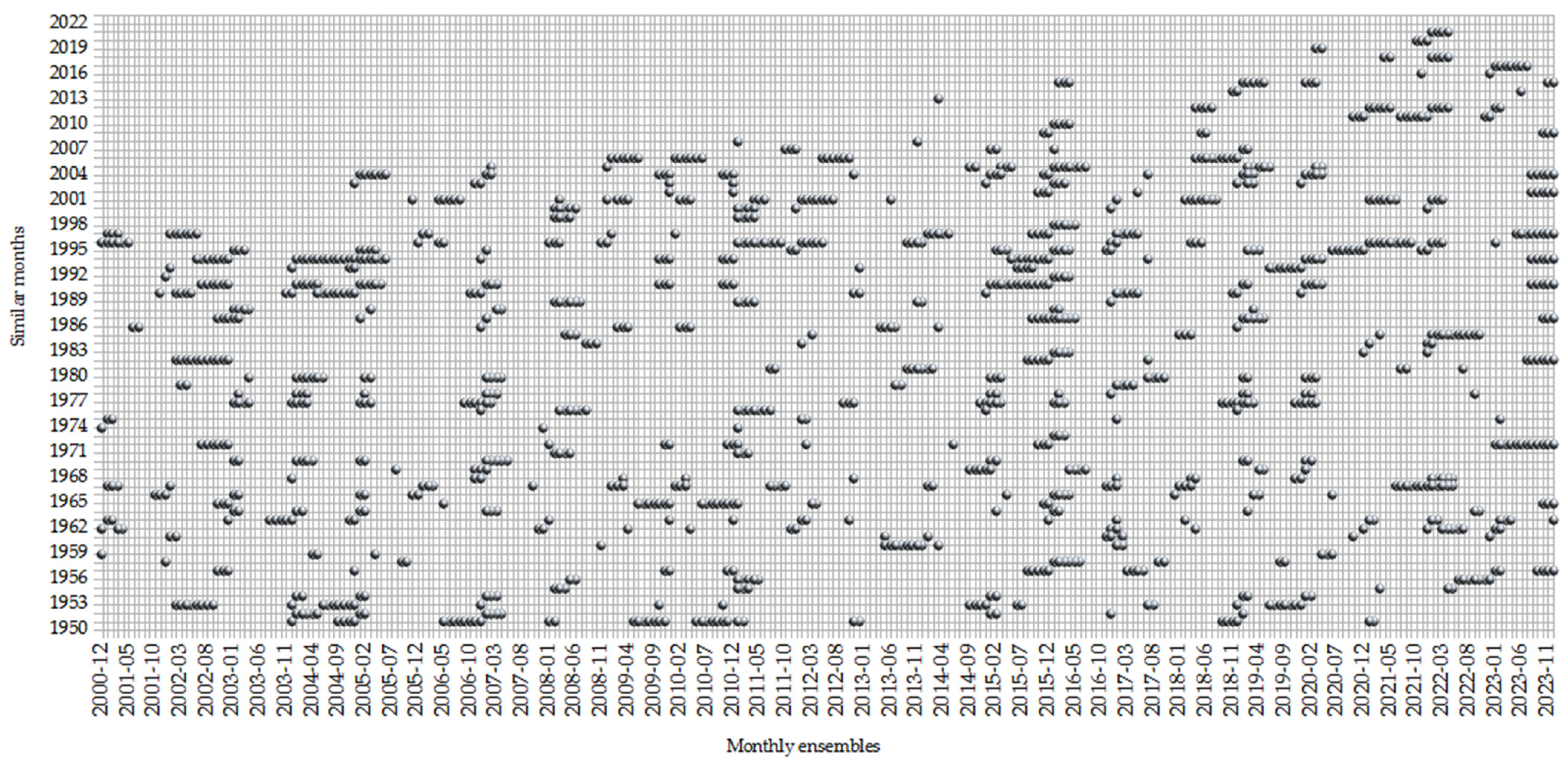
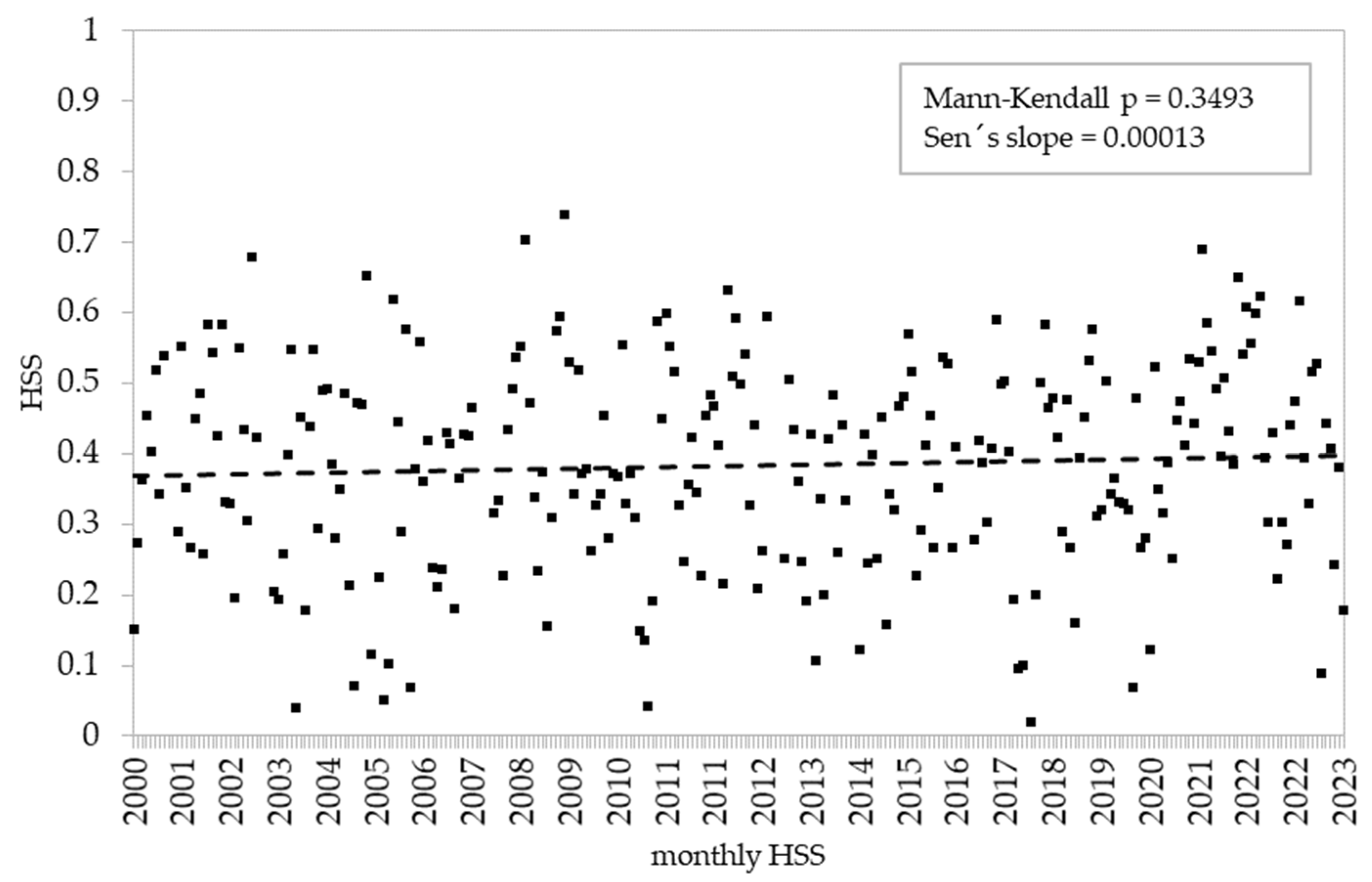

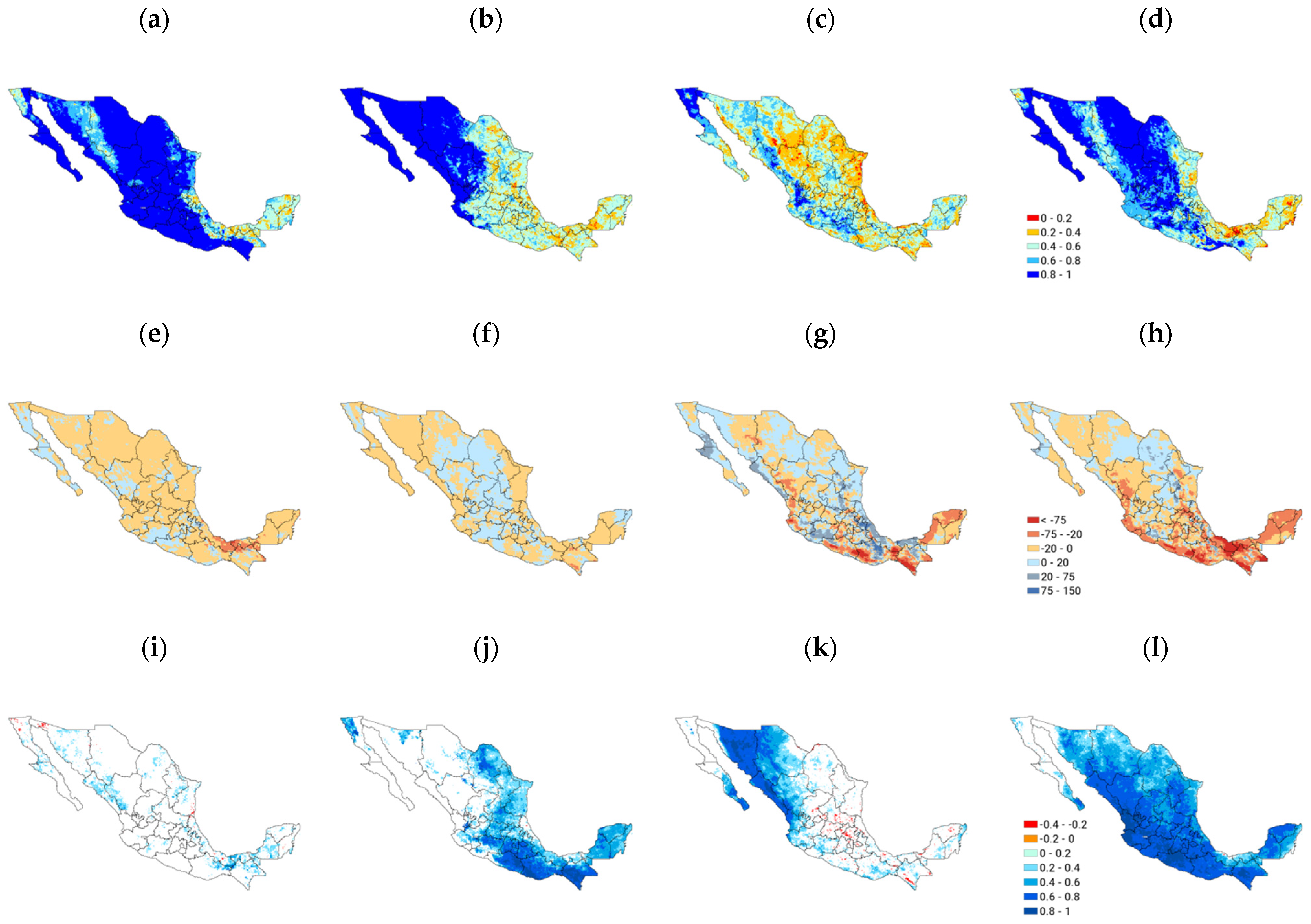
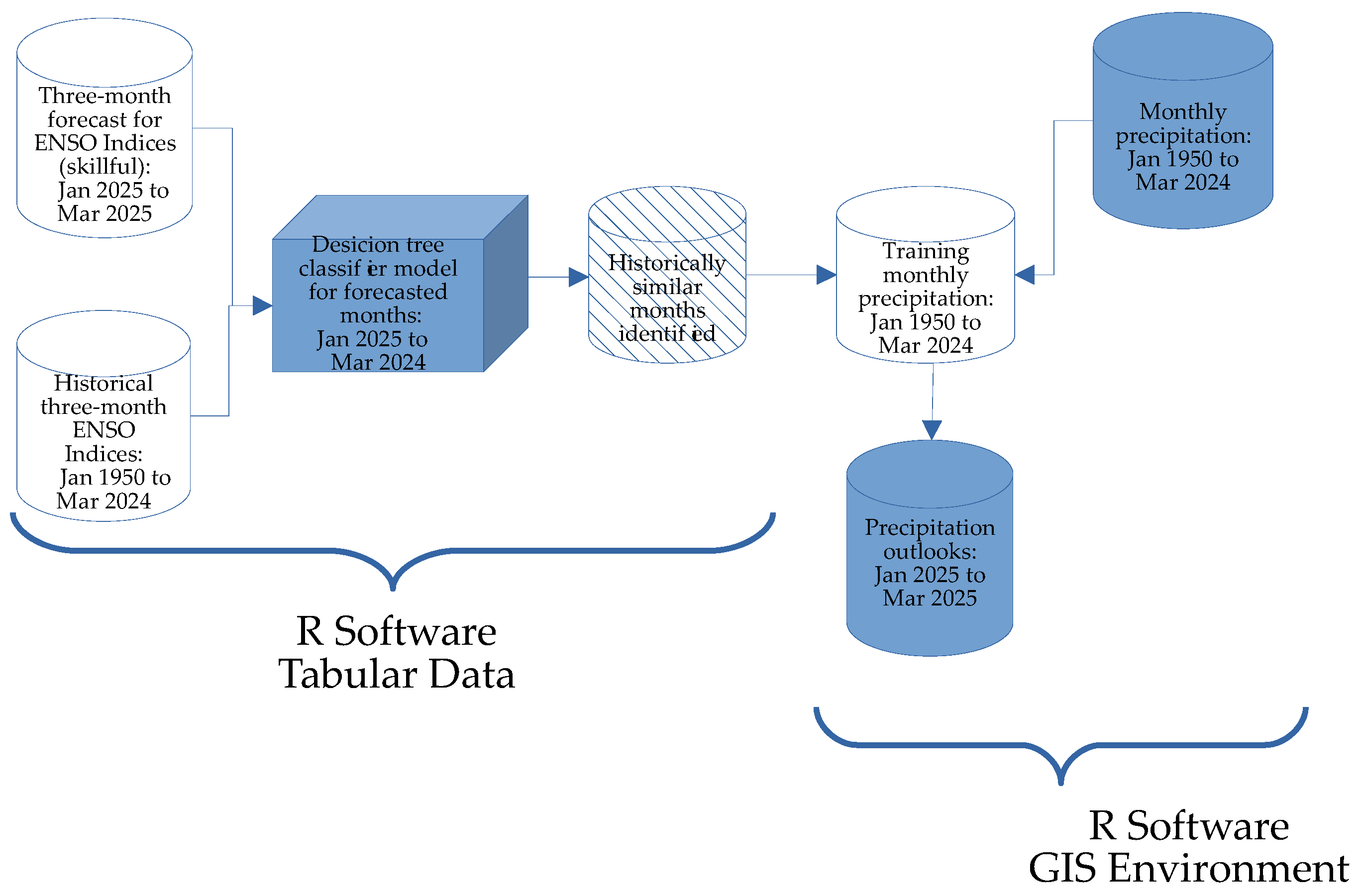
| National | Local | ||
|---|---|---|---|
| Hansen–Kuiper Skill Score (KSS) | [Σp(f,o) − Σp(f)p(o)]/[1 − Σ(p(f)2] | Spearman correlation (srho) | 1 − ((6Σd2)/(n3 − n)) |
| Heidke Skill Score (HSS) | [Σp(f,o) − Σp(f)p(o)]/[1 − Σp(f)p(o)] | Percent of correct (sPC) | hits/number of events |
| Probability of detection (POD) | hits/hits+misses | Bias (sBias) | forecast − observed |
| Mean Absolute Error | Σ 1/n |forecast − observed| | ||
| Event | Seasons | ∑ | |||
|---|---|---|---|---|---|
| DJF | MAM | JJA | SON | ||
| Cool | 28 | 28 | 13 | 18 | 87 |
| Neutral | 22 | 24 | 47 | 40 | 133 |
| Warm | 19 | 17 | 9 | 11 | 56 |
| Metric | Seasons | |||
|---|---|---|---|---|
| DJF | MAM | JJA | SON | |
| KSS | 0.41 | 0.48 | 0.37 | 0.32 |
| HSS | 0.40 | 0.45 | 0.37 | 0.31 |
| MAE | 11 | 13 | 52 | 44 |
Disclaimer/Publisher’s Note: The statements, opinions and data contained in all publications are solely those of the individual author(s) and contributor(s) and not of MDPI and/or the editor(s). MDPI and/or the editor(s) disclaim responsibility for any injury to people or property resulting from any ideas, methods, instructions or products referred to in the content. |
© 2024 by the authors. Licensee MDPI, Basel, Switzerland. This article is an open access article distributed under the terms and conditions of the Creative Commons Attribution (CC BY) license (https://creativecommons.org/licenses/by/4.0/).
Share and Cite
González-González, M.A.; Corrales-Suastegui, A. Monthly Precipitation Outlooks for Mexico Using El Niño Southern Oscillation Indices Approach. Atmosphere 2024, 15, 981. https://doi.org/10.3390/atmos15080981
González-González MA, Corrales-Suastegui A. Monthly Precipitation Outlooks for Mexico Using El Niño Southern Oscillation Indices Approach. Atmosphere. 2024; 15(8):981. https://doi.org/10.3390/atmos15080981
Chicago/Turabian StyleGonzález-González, Miguel Angel, and Arturo Corrales-Suastegui. 2024. "Monthly Precipitation Outlooks for Mexico Using El Niño Southern Oscillation Indices Approach" Atmosphere 15, no. 8: 981. https://doi.org/10.3390/atmos15080981





